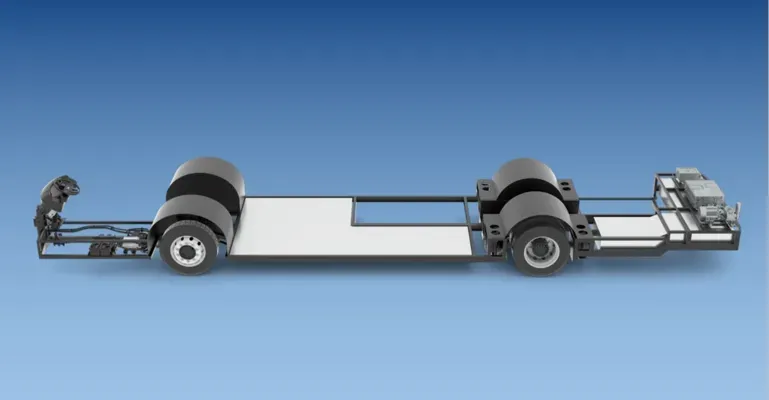The BYD electric bus platform revolutionizes the landscape of electric public transport, positioning itself at the forefront of electric bus technology. With its cutting-edge e-Bus Platform 3.0, BYD offers a remarkable high-voltage bus system featuring a 1,000-volt architecture that not only enhances stability but also supports ultra-fast charging capabilities. Notably, the introduction of the BYD C11 bus showcases a range of battery configurations, providing transit systems with flexibility and an impressive driving range of up to 454 miles. This innovative platform also includes advanced features like adaptive suspension buses that significantly improve ride comfort, making public transport a more attractive option for commuters. As BYD continues to lead the charge in sustainable transportation solutions, the integration of high-performance technology shapes the future of urban transit systems worldwide.
The latest innovation in sustainable transport is the BYD electric bus platform, a game-changer in the realm of environmentally friendly transportation. This state-of-the-art bus system incorporates advanced electric vehicle technologies that redefine the efficiency and performance of urban transit. The introduction of the BYD C11 model highlights the platform’s adaptability, featuring a wide selection of power options suited for diverse transit needs. Moreover, the integration of features designed for ultimate safety and comfort, such as adaptive suspension and emergency stop systems, elevates the standard for public transport vehicles. As cities expand their commitment to greener travel solutions, platforms like BYD’s e-Bus 3.0 are vital in driving this transformation.
Transforming Public Transport with BYD Electric Bus Technology
The introduction of BYD’s electric bus platform marks a significant milestone in the revolution of public transport systems. With its advanced e-Bus Platform 3.0, BYD has engineered a vehicle that integrates not only high-performance but also sustainable technology. The platform is designed with a 1,000-volt architecture that allows for rapid charging and longer driving ranges, providing an effective solution for modern public transit needs. With cities worldwide increasingly focusing on reducing their carbon footprint, the transition to electric public transport through innovations like BYD’s platform is timely and critical.
Additionally, the features of the BYD C11 electric bus, which includes a driving range of up to 454 miles on a single charge, epitomize how electric bus technology can enhance operational efficiency in urban areas. The implementation of cell-to-chassis lithium-iron-phosphate (LFP) batteries not only optimizes space but also improves the overall weight distribution of the bus. This innovative design approach is likely to attract more municipalities to consider transitioning their fleets towards electric models, paving the way for a more sustainable future in public transport.
The BYD C11: A Game-Changer in Electric Public Transport
The BYD C11 serves as the flagship model demonstrating the capabilities of BYD’s cutting-edge electric bus platform. Available in multiple configurations, the C11 offers options ranging from 184 kilowatt-hours to 593 kilowatt-hours, catering to diverse transit needs from local shuttles to long-distance services. This flexibility not only increases the versatility of electric public transport but also assures fleet operators that they can choose a model that best fits their operational requirements.
Moreover, the C11’s impressive driving range from 136 miles to 453 miles supports various transit scenarios, thus alleviating concerns about the limitations of electric buses. The integration of high-voltage bus systems within the C11 facilitates ultra-fast charging, essential for keeping buses on the road and minimizing downtime during operations. As cities look to modernize their fleets, the BYD C11 stands out as a formidable option to enhance public transportation infrastructure.
Advanced Features of BYD’s E-Bus Platform 3.0
BYD’s e-Bus Platform 3.0 is packed with advanced features designed to ensure safety and efficiency in public transportation. One noteworthy innovation is the adaptive suspension system known as DiSus-A, which offers superior comfort for passengers while handling the challenges of urban environments. This adaptation from the passenger EV sector effectively enhances bus performance and driving experience, marking a shift from conventional bus systems to high-tech alternatives.
Moreover, the inclusion of a high-speed tire blowout stability system is a testament to BYD’s commitment to safety. This system provides instant response capabilities, ensuring that buses can maintain stability during incidents that could otherwise lead to accidents. These sophisticated safety features represent a significant upgrade from traditional bus designs, showcasing how electric bus technology can be integrated with modern engineering for improved public transport solutions.
The Impact of Adaptive Suspension on Bus Performance
The integration of an adaptive suspension system in BYD’s electric buses transforms the driving experience significantly. The DiSus-A system adjusts to various road conditions instantaneously, providing a smoother ride for passengers and reducing wear on bus components. This technological advancement not only enhances user comfort but also boosts operational efficiency by maintaining better handling and traction in challenging conditions.
Furthermore, adaptive suspension systems can lead to lower maintenance costs over time, making electric public transport more economically viable. As cities and transit authorities evaluate the total cost of ownership for their fleets, features like these become essential factors in decision-making, ultimately supporting the broader adoption of electric buses across various regions.
High-Voltage Bus Systems: Charging Ahead in Electric Mobility
The introduction of high-voltage bus systems, such as the 1,000-volt architecture utilized in BYD’s e-Bus Platform 3.0, heralds a new era for electric mobility. This high-voltage capability not only facilitates faster charging but also enhances the overall efficiency of battery usage during operation, directly impacting the bus’s performance and energy consumption.
Moreover, the ability to charge at high voltages opens the door for the development of rapid charging stations, which can significantly reduce downtime for buses in service. As urban areas increasingly focus on sustainable transport solutions, high-voltage systems could prove crucial for achieving the operational efficiencies necessary for modern electric public transport networks.
Safety Innovations: Enhancing Passenger Security in Electric Buses
Safety is a paramount concern for any mode of transportation, and BYD has addressed this through its innovative safety features in the e-Bus Platform 3.0. The inclusion of the Driver Disability Assistance System 2.0, which allows passengers to halt the bus automatically in case of an emergency, exemplifies BYD’s commitment to passenger safety. This feature minimizes risks and adds an extra layer of security for both drivers and riders.
Additionally, these new safety technologies are particularly beneficial as public transport systems adapt to new challenges posed by urban traffic and heightened passenger expectations. With a focus on creating safer and more reliable transit systems, BYD’s innovations set a new standard for safety in electric public transportation.
The Role of Electric Bus Technology in Sustainable Urban Development
Electric bus technology is poised to play a central role in sustainable urban development. With growing concerns regarding air quality and climate change, cities are seeking effective strategies to reduce emissions from public transport. BYD’s electric buses, equipped with advanced technologies like cell-to-chassis batteries and adaptive suspensions, provide a clean alternative to traditional diesel buses, thereby contributing to a greener urban future.
As more cities worldwide commit to sustainability goals, the adoption of electric public transport systems becomes increasingly urgent. The capabilities of BYD’s e-Bus Platform 3.0 may inspire other manufacturers to innovate, further accelerating the shift to eco-friendly transport solutions and fostering a culture of sustainability at the city level.
Future Prospects: Bringing BYD Technology to Global Markets
As BYD continues to innovate within the electric bus sector, the potential for introducing its e-Bus Platform 3.0 to global markets remains strong. With existing manufacturing operations in California, the U.S. presents a lucrative opportunity for BYD to expand its reach. As North American cities explore strategies for modernizing their transit systems, the advanced technologies included in BYD’s platform could meet local demands for efficiency, safety, and environmental responsibility.
Moreover, as other countries ramp up their electric mobility initiatives, BYD stands well-positioned to offer solutions that can adapt to various regulatory environments and user needs. This expansion could not only enhance BYD’s presence internationally but also contribute significantly to the global shift towards cleaner, smarter public transport systems.
The Importance of Research and Innovation in Electric Public Transport
Continuous research and innovation are crucial for the growth of electric public transport technologies. By integrating lessons learned from the passenger vehicle market, BYD has leveraged its expertise to create enhanced public transport solutions. The exploration of new materials and technologies, including advanced battery systems and high-voltage architectures, is essential for driving both performance improvements and cost reductions.
Investments in research and development will ensure that electric buses remain competitive against traditional vehicles while also addressing emerging challenges in urban transport. As stakeholders in the public transport sector invest in innovation, companies like BYD can lead the charge in pioneering sustainable transportation technologies for the future.
Frequently Asked Questions
What is the BYD electric bus platform and how does it enhance electric public transport?
The BYD electric bus platform, specifically the e-Bus Platform 3.0, significantly enhances electric public transport by integrating a 1,000-volt architecture and advanced electric bus technology. It features cell-to-chassis lithium iron phosphate (LFP) batteries that allow for a lower bus floor, improving accessibility. With a driving range of up to 454 miles, this platform meets the demands of both local and regional transit services.
What makes the BYD C11 special in terms of electric bus technology?
The BYD C11, the first bus built on the new electric bus platform, is notable for its five battery capacity options ranging from 184 kilowatt-hours to 593 kilowatt-hours, offering a CLTC-rated range from 136 to 453 miles. This versatility makes it suitable for various public transport needs, demonstrating the potential of BYD’s electric bus technology.
How does the high-voltage bus system in BYD’s electric bus platform contribute to performance?
The high-voltage bus system in the BYD electric bus platform operates at a groundbreaking 1,000 volts, allowing for ultra-fast charging capabilities and improving the overall efficiency of the bus. This technology is essential for enhancing the performance and reliability of electric public transport, facilitating quick turnarounds for transit services.
What is the role of adaptive suspension buses in the BYD electric bus platform?
Adaptive suspension buses, equipped with BYD’s DiSus-A technology, provide a smoother ride by adjusting to varying road conditions in real-time. This innovation enhances passenger comfort and safety, showcasing BYD’s commitment to integrating advanced technology in its electric bus platform.
What safety features are included in the BYD electric bus platform?
The BYD electric bus platform incorporates several innovative safety features, including a high-speed tire blowout stability system that stabilizes the bus during tire failures. Additionally, the Driver Disability Assistance System 2.0 allows passengers to bring the bus to a stop automatically in emergency situations, ensuring the safety of all onboard.
Will the BYD electric bus platform be introduced in the US market?
While BYD has not yet introduced passenger EVs in the U.S., it has been manufacturing battery-powered buses in California since 2013. Given the innovation and proven technology of the BYD electric bus platform, including the advanced suspension system and high-voltage battery design, it is plausible for these features to be adopted in U.S. transit buses in the future.
| Feature | Details |
|---|---|
| Platform Name | e-Bus Platform 3.0 |
| Voltage Architecture | 1,000 volts |
| Driving Range | Up to 454 miles |
| Battery Type | Cell-to-chassis Lithium Iron Phosphate (LFP) |
| Adaptive Suspension System | DiSus-A system adapted from passenger EVs |
| Safety Features | Driver Disability Assistance System 2.0 for emergency stops |
| First Model | C11 with five capacity options |
| Charging Capability | Ultra-fast charging capability at 1,000 volts |
Summary
The BYD electric bus platform represents a groundbreaking advancement in public transport, integrating cutting-edge technology and safety features that redefine the standards for buses. With its innovative e-Bus Platform 3.0, BYD is not just enhancing the efficiency and performance of electric buses, but also paving the way for smarter, safer public transportation options. This platform’s adoption could revolutionize the public transport sector, ushering in an era of environmentally friendly and technologically advanced transit solutions.



























